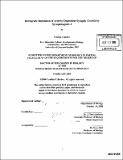Retrograde regulation of activity-dependent synaptic growth by Synaptotagmin 4
Author(s)
Barber, Cynthia F
DownloadFull printable version (40.34Mb)
Other Contributors
Massachusetts Institute of Technology. Dept. of Biology.
Advisor
J. Troy Littleton.
Terms of use
Metadata
Show full item recordAbstract
Ca2+ influx into pre- and post-synaptic compartments during neuronal activity is a key mediator of neurotransmitter release and synaptic plasticity. Although the role of presynaptic Ca2+ in triggering vesicle fusion is established, molecular mechanisms that underlie responses to postsynaptic Ca2+ remain unknown. The Synaptotagmin family of Ca2+ sensors includes several evolutionarily conserved neuronal isoforms that are predicted to regulate vesicle fusion, including the synaptic vesicle Ca2+ sensor Synaptotagmin 1. Recently, the Synaptotagmin 4 (Syt 4) isoform was localized to postsynaptic vesicles at Drosophila neuromuscular junctions (NMJs), suggesting a role in Ca2+-dependent release of retrograde signals. Here we demonstrate that fusioncompetent Syt 4 vesicles localize postsynaptically in Drosophila central nervous system (CNS) neurons, suggesting Syt 4 may be a general regulator of postsynaptic vesicle trafficking. Syt 4 mRNA and protein levels are bi-directionally regulated by neuronal activity, with seizure induction increasing Syt 4 levels and decreased activity reducing Syt 4 expression. Bi-directional manipulations of postsynaptic Syt 4 levels in vivo demonstrate that it regulates synaptic growth at NMJs, with Syt 4 mutants showing reduced varicosity number. Postsynaptic over-expression of Syt 4 enhances synaptic growth and requires Ca2+ binding by both the C2A and C2B domains, as well as serine 284, an evolutionarily conserved substitution for a key C2A Ca2+-binding aspartic acid found in other synaptotagmin isoforms. In addition, Syt 4 is required for activitydependent structural plasticity at NMJs, including seizure-induced and temperaturedependent synaptic growth. These findings suggest retrograde vesicular trafficking mediated by Syt 4 contributes to activity-dependent growth of neuronal connections.
Description
Thesis (Ph. D.)--Massachusetts Institute of Technology, Dept. of Biology, 2009. Includes bibliographical references.
Date issued
2009Department
Massachusetts Institute of Technology. Department of BiologyPublisher
Massachusetts Institute of Technology
Keywords
Biology.